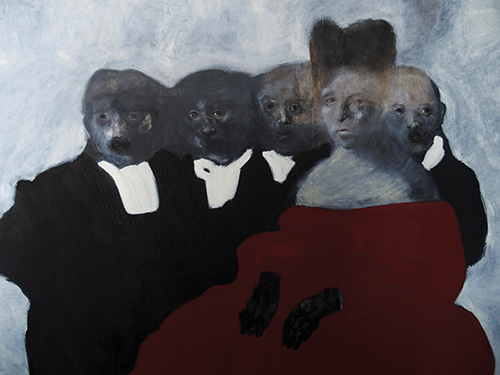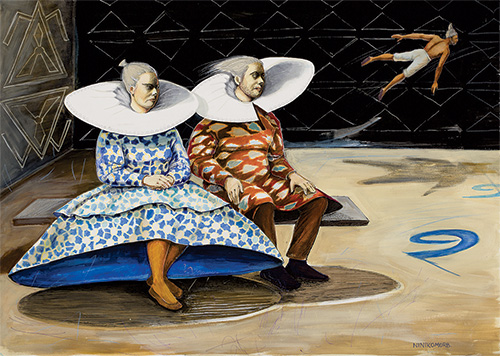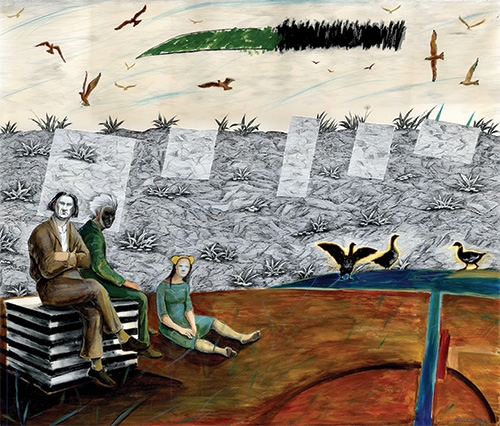Framing Georgian Art as an Investment
"Tbilisi’s art scene has been steadily growing over the past decade, and the city now has the potential to become a regional epicenter for the arts, but before that can happen, price and trend monitoring, artist ratings and buyer infrastructure needs to be developed," reads the article published by Investor.ge, written by Sally White.
The author notes that tracking values of contemporary Georgian art through the galleries and sales rooms is no easy task. Georgian art seldom comes up at international auctions, there are few large-scale regional exhibitions, no price monitoring and most sales are made privately between artists and collectors.
"This lack of infrastructure has been a major put-off for buyers, particularly international ones, who want the full marketing back-up, with prices and trends," reads the publication.
However, it further reads, the latest project by the owner of one of Tbilisi’s longest established galleries, Baia Tsikoridze, could help change this and revolutionize the Georgian art market.
Tskoridze is building an online platform to provide access to all the information buyers want, with statistics and details on sales, artist ratings and a price index. She hopes to be able to launch the platform next year.
Since the inception of Baia Gallery 27 years ago, Baia says the gallery has been “been researching the market and owns an extensive database of photo and documentary materials on the works it has sold and their prices, and has created a price index; it has also explored the available results of works by Georgian artists sold at international auctions and on the local market.”
A wave of interest in Georgian art was started by a major exhibition and sale at leading international auctioneer Sotheby’s, “Art at the Crossroads”, held in London back in 2013.
It included 10 Georgian artists among those on show which focused on Central Asia and the Caucasus. Apart from introducing regional artists to the outside world, Sotheby’s purpose was to connect with the wealthy in these regions and encourage local interest in art purchases.
"Sadly, after 2014 Sotheby’s dropped this exhibition. However, in Georgia, the Expo Georgia Convention Center’s Supervisory Board chairman, Kaha Gvelesiani and its creative director, Nino Gamrekeli, took up the challenge and in 2018 organized the Tbilisi Art Fair, which has become an annual international event," reads the article.
The author notes that there is certainly no shortage of collectible work by contemporary Georgian artists – though they are scattered around the world – from paintings and drawings to installations, textiles and cloisonné enamel work. There is even a flourishing Georgian street-art scene emerging, most famously the murals on Tbilisi’s’ iconic hostel complex Fabrika, although Georgia has yet to produce its own graffiti artist to rival the eminently stealable (often with hammers and chisels) works by Banksy.
Nor is there a shortage of galleries. Tbilisi has a number of well-established ones including Baia Gallery, Vanda Art Gallery, Chardin Gallery, Vernisage Gallery, Gamrekeli Gallery and Dedicace Gallery. There are new galleries opening, especially in Vake, though many of these are catering to interior designers rather than collectors.
Artists need patrons and promoters, and as Ia Dvali (founder of the Chardin Gallery along with fellow art critics Khatuna Chkheidze and Maia Nozadze) says, the economic downturn has caused “investment in art to slow down a little bit in Georgia”. Fortunately, to help offset that, the internet has brought in foreign online customers. Those buying for investment, she says are interested “in both contemporary artists and in earlier paintings”.
Chardin Gallery, which sells mainly contemporary Georgian fine and applied art, including some amazing cloisonné enamel work, puts a wide price range on the artists attracting the most attention currently of $500 to $50,000. Artists, both past and living, which Ia Dvali includes in her list of those “whose value and recognition are slowly but surely growing”, are Vera Pagava, Felix Varlamishvili, Natela Iankoshvili, Tengiz Mirzashvili, Edmond Kalanandadze, Jemal Kukhalashvili, Irakli Sutidze and Ushangi Khumarashvili. Established artists from the last century, such as David Kakabadze, Elene Akhvlediani and Lado Gudiashvili, she says, enjoy “stable and high prices” at her gallery.
At Vanda Gallery, (which very actively promotes contemporary and young artists via its international mailing list and regular shows) the Georgian art market is described as “quite active” with “more young and new art collectors emerging”. The gallery, run by Vanda Mujiri and her brother Sandro, has a long list of promising young artists – Rita Khachaturyan, Tedo Rekhviashvili, George Gatserelia, George Gagoshidze, Levan Mindiashvili, Vaho Bugadze, Zurab Gikashvili, Alex Berdisheff, George Gugushvili, Shalva Matuashvili, Kako Topuria, Tengiz Marr, Temo Javakhishvili, Jemal Kukhalashvili and Gogi Chagelishvili – who sell at anything “between $1,000 and tens of thousands of dollars”.
However, “it is hard to predict which artist can be the best investment, everything depends on promotion and the artist himself. At this time, probably the most promising artist in Tbilisi in our view is Rita Khachaturyan, who is already considered one of the strongest Georgian artists”, they say.

Rita Khachaturyan – ‘The Guest’ – from the series ‘Fear’, Oil on Canvas. $12,500.
Who is buying Georgian art?
Baia Tsikoridze says that while the market is active “most of the buyers are Georgians or our compatriots living abroad, with a smaller proportion of foreigners working in Georgia,” which is unsurprising, given the relative lack of international publicity. However, there are foreign buyers, including some who have built large collections.
And her choice of best investments – Guranda Klibadze, Niniko Morbedadze, Tutu Kiladze, Rita Khachatryan, Jibson Khundadze, Vakho Bugadze and Kote Sulaberidze.

Niniko Morbedadze – ‘Flight Lessons.’ Acrylic, Indian ink on paper, 50 x 69,5 cm. 2016.
The Georgian galleries have been doing their best to help local artists find buyers on international markets, as Sandro Mujiri points out, taking them to overseas fairs, even in the hard times of the 1990s when the cultural support enjoyed in Soviet times was lacking. However, there is a huge amount of competition out there, and as Katrine Levin says, while Georgian artists are known and appreciated by Georgians, “….geographic distance from cultural epicenters like London and New York make it difficult for Georgian artists living in Georgia to be discovered internationally.”
Hence, the value of the Tbilisi Art Fair and other events with international ambitions and a focus on local talent. She adds, referring to her Georgian artists: “In both cases, I went to Georgia to meet the artist.”
Author: Sally White
Source: investor.ge
Main photo: Niniko Morbedadze – ‘About Mystical Places #1’











